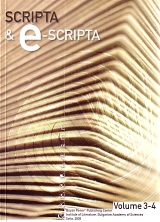Morphonological Restrains on the Loss of the Weak Yers in Prefixes and Suffixes
Morphonological Restrains on the Loss of the Weak Yers in Prefixes and Suffixes
Author(s): Anna-Maria TotomanovaSubject(s): Language and Literature Studies
Published by: Институт за литература - БАН
Keywords: Bulgarian phonetic; weak yers; morphological analysis; prefixes; suffixes
Summary/Abstract: In the article consequently have been analyzed all cases with a held weak “yer” in the prefixes “sa-“, “va-“ and “vaz-“ in the contemporary Bulgarian language. In the prefix ”sa-“ the “yer” vowel is kept not only before a following root with an initial s or z, but also before any kind of consonants, compare sabariam, sabitie, sablazan, sablicham, sabludavam, saboleznovavam, sabudia, sabuia, savet, saveshtavam, saglasna, saglasia se, sadeistvam, sajalia, sakrusha, sachinia, sashia. Before a following consonant the “yer” is always kept, compare for example saedinia, saesha, saoraja, saumeia, saorudia, saobrazia, etc. Especially significant are the cases where with one and the same morpheme structure, once the “yer” has dropped, as its phonetic position requires, and in another – it is preserved. Such cases are not scanty in the Bulgarian language, compare sbera, sbiram, sbor, but sabera, sabiram, sabor; svestia, sviast, savest; svarshen and savarshen, sgledam, sgleda and sagledam; sgrada and sagradia; sgresha and sagresha; sdruja and sadruja; sdarjam and sadarjam; skria, skrit, but sakroven, sakrovishte; spregna and saprejen; storia and satvoria. The prefix “va-“ usually loses its final yer before following verb roots with an initial consonant, as here, the very peculiarity of the newly formed consonant combination (in a number of cases in full contradiction with the inherited from proto-Slavonic structure of the syllable, compare vstapvam, vstrastiavam, vsmukvam, vsmakvam) helps the morpheme parsing of the word and the distinguishing of the prefix. The generalization of the preposition- prefix as f in the colloquial language is also an expression of the aspiration to achieve a clear morpheme structure. In the prefix “vaz-“ with exception of some Russian borrowings such as vzriv and vzvod the weak yer is always kept. The only exception in a domestic word is the verb vzema, which in Bulgarian is considered to be formed by zema and the prefix v, as we can see from its derivatives – izzema, vazzema, etc., whose fate clearly shows that the drop of the yer in vaz- leads to the breaking of the uniform morpheme vz- in the preposition v- and the initial root z- to an undesired decomposition of the word. The behaviour of the weak yer-s in the suffixes is also subject of morphological restrictions, mostly connected with the aspiration to generalize the base of the word. In some cases the holding of the weak yer brings additional grammatical information: in the suffix –aka the yer is held in a weak position, only if the substantive is a noun, compare jaltak, jaltaci and malak, malki; the countable form and the definite form of the masculine nouns also hold the weak yer, etc. The detailed analysis shows that similar to the behaviour of the root yer-s, the behaviour of the yer-s in the prefixes and suffixes is also subject mainly of morphological and morphonological regularities and in a smaller degree it simply depends on phonetical conditions.
Journal: Scripta & e-Scripta
- Issue Year: 2006
- Issue No: 3-4
- Page Range: 33-42
- Page Count: 9
- Language: English
- Content File-PDF

